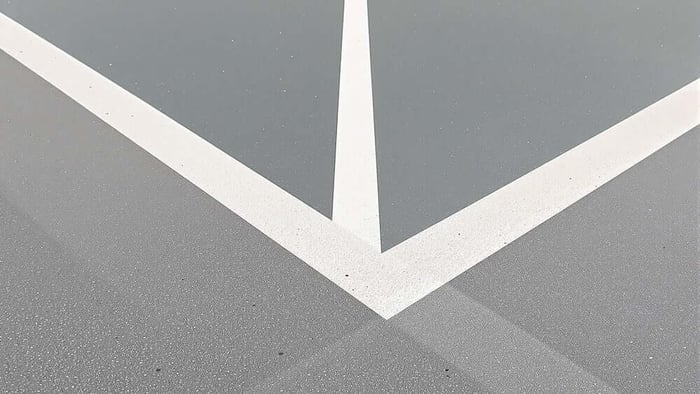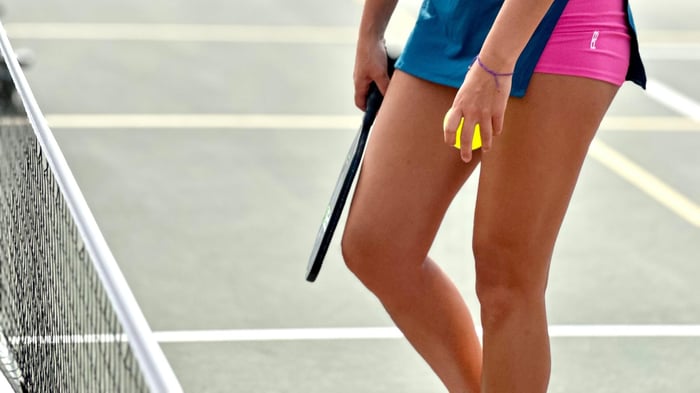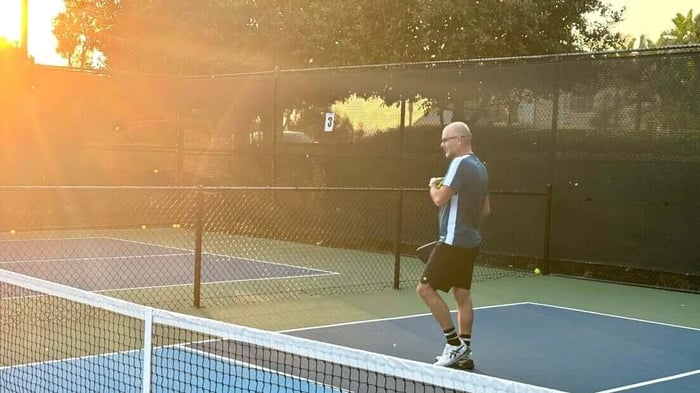Key takeaways:
To create a regulation pickleball court, a minimum of 30 feet by 60 feet is needed, with optimal dimensions being 34 feet by 64 feet for ample play and social space.
Creating buffer zones of at least 5 feet on the sides and 10 feet at the ends enhances safety and fosters community by providing space for social interactions.
The right location and design—considering factors like sunlight, terrain, and accessibility—are crucial to optimizing your pickleball court for both gameplay and communal enjoyment.
The pickleball playing area is smaller than a tennis court but larger than a badminton court. This mid-range size helps make it accessible to beginners while still challenging for experienced players since it means less running than tennis. It creates a game that's approachable for players of all ages and fitness levels while still delivering an excellent workout.
In this article, we'll break down pickleball court dimensions into simple, clear explanations. We’ll guide you through the complete court layout and explain how each area functions in gameplay, giving you practical knowledge for playing and building your own court. For a complete pickleball experience, your gear should also be comfortable and high quality. Browse our selection at PB5star.
Setting up your own court
Setting up a pickleball court is easier than you might think. With the right measurements, materials, and planning, you can turn almost any flat surface into a functional pickleball court.
Space requirements
While the actual playing surface of a pickleball court is 20 feet by 44 feet, you'll need additional space around the court for player movement and safety. A minimum area of 30 feet by 60 feet is recommended to give players room to move safely when chasing balls or making running shots.
If you're setting up indoors, make sure your ceiling height is at least 20 feet to accommodate high lobs without interference. For shared spaces like driveways or multi-purpose areas, just make sure there's enough clearance from obstacles like cars, gardens, or playground equipment.
Temporary vs. permanent court options
When creating your own pickleball space, you have two main options to consider, depending on your needs, budget, and available space. Temporary courts offer flexibility and affordability for occasional players, while permanent installations provide a premium playing experience for dedicated enthusiasts. Below are a few points to consider for each type.
Temporary courts:
Perfect for occasional play or multi-use spaces like driveways and cul-de-sacs
Can be set up using portable nets and temporary line markers
Typically takes 15-30 minutes to set up and take down
Cost-effective option starting around $150-$300 for basic equipment
Permanent courts:
Ideal for dedicated playing spaces or converting existing courts
Requires proper surfacing (concrete, asphalt, or specialized pickleball surfacing)
Permanent line painting or tape installation
Fixed net posts and potentially fencing
More expensive but offers a superior playing experience ($2,000-$10,000+ depending on existing surface)
DIY court marking tips
Mapping out your pickleball court doesn't have to be complicated or expensive. With the right approach, you can create professional-looking lines that enhance gameplay and provide clear boundaries.
For temporary courts:
Use chalk for concrete/asphalt surfaces (washes away with rain)
Painter's tape works well for indoor surfaces (removes easily without residue)
Flat rope or weighted string can create temporary lines on grass
For permanent courts:
Use specialized court paint that provides good visibility and traction
Standard line width should be 2 inches
White or yellow colors offer the best visibility
Consider using templates or hiring professionals for precise measurements
Apply a court sealer after painting to extend the life of your lines
Pro tip: When measuring, start from the center of the court (where the net goes) and work outward to ensure your court is properly centered in your available space.
Portable net systems and their standard measurements
When it comes to pickleball nets, you've got two main options: Regulation nets and portable nets.
Regulation nets are built for permanent courts and official play. They're sturdy, fixed in place, and perfect if you've got a dedicated space for pickleball.
Portable nets, however, give you flexibility without compromising on standards. They maintain the same official dimensions but can be set up anywhere—your driveway, a local park, or when visiting friends.
These portable systems are ideal if you're short on permanent space, like to play in different locations, or want to introduce friends to the game without a major investment. While they might need occasional tightening during play, most quality portable nets will serve you well for casual games and practice sessions.
A regulation pickleball net should be:
22 feet wide (extending 1 foot beyond each sideline)
36 inches high at the sidelines
34 inches high at the center
Made of mesh that prevents balls from passing through
Portable net systems typically include:
A collapsible frame (usually aluminum or steel)
Adjustable height settings
A carrying case for easy transport
Weight around 15-25 pounds
Quality portable nets range from $100-$300 and most can be assembled in under 10 minutes. Look for systems with stable bases that won't tip over during play and tension adjustments to keep the net taut.
If you’re budget-conscious, you can even create a makeshift net system using rope strung between two poles or trees, though this isn't ideal for competitive play. While DIY courts may not meet exact tournament specifications, they're perfect for recreational play and practicing your skills.
Choosing a suitable location for your pickleball court
Before you start measuring and marking lines, let's talk about finding the right spot for your court. The location you choose can make the difference between a fun playing experience and one that will drive you crazy every time you step onto the court.
Flat, level surface
The ideal location for a pickleball court requires a flat, level surface. Even slight slopes or uneven areas can affect ball bounce and player movement, potentially leading to injuries or an inconsistent playing experience. Before finalizing your location, use a level to check for any significant grade changes across your proposed court area.
Sun orientation
The optimal orientation for outdoor courts is north-south, which prevents players from facing directly into the rising or setting sun during play. While not always possible due to space constraints, positioning your court to minimize sun glare will significantly improve the playing experience.
Wind exposure
Consider how wind patterns affect your chosen location. Areas with consistently strong winds or locations that create wind tunnels (like between buildings) can make play challenging, as the lightweight pickleball is easily affected by air currents. If possible, choose a location that offers some wind protection, such as near tree lines or buildings that can serve as windbreaks.
Proper drainage
Proper drainage is crucial for outdoor courts. Standing water not only makes play impossible but can also damage court surfaces over time. Ensure your location has adequate natural drainage or plan to incorporate drainage solutions in your court construction.
Creating your perfect pickleball space
A huge part of pickleball's appeal lies in its well-designed court that accommodates players of all skill levels and ages. Whether you choose a temporary setup with chalk lines or invest in a permanent court with proper surfacing, knowing the dimensions and requirements helps create a space that optimizes both gameplay and safety. For maximum performance and enjoyment, you don’t just need a good court, but great apparel to complement it. Browse our full selection at PB5star.
FAQs
How much space makes for amazing gameplay?
Give your game room to breathe with at least 5 feet of clear space on each side of the court. Want to play like a pro? Extend that to 10 feet for maximum movement and style on the court. This extra space lets you chase down those tricky shots.
What should I know about transforming my driveway into a court?
Driveways make great starting points for casual games with friends. The perfect setup needs about 30 by 60 feet of flat space—if your driveway meets these specs, you're golden for creating your pickleball court.
What's your best advice for keeping courts playable year-round?
Keep your court looking and playing beautiful with regular cleaning and quick fixes for any surface issues. Our guide gives you the complete picture of setting up and maintaining your private court.
How can I make the most of limited space?
If you're working with limited space, consider using temporary nets and portable boundary markers that can be easily set up and removed. For very tight spaces, half-courts can still provide enjoyable gameplay for small groups or practice sessions. Strategic placement against existing structures like fences or walls can save space while providing natural boundaries.







